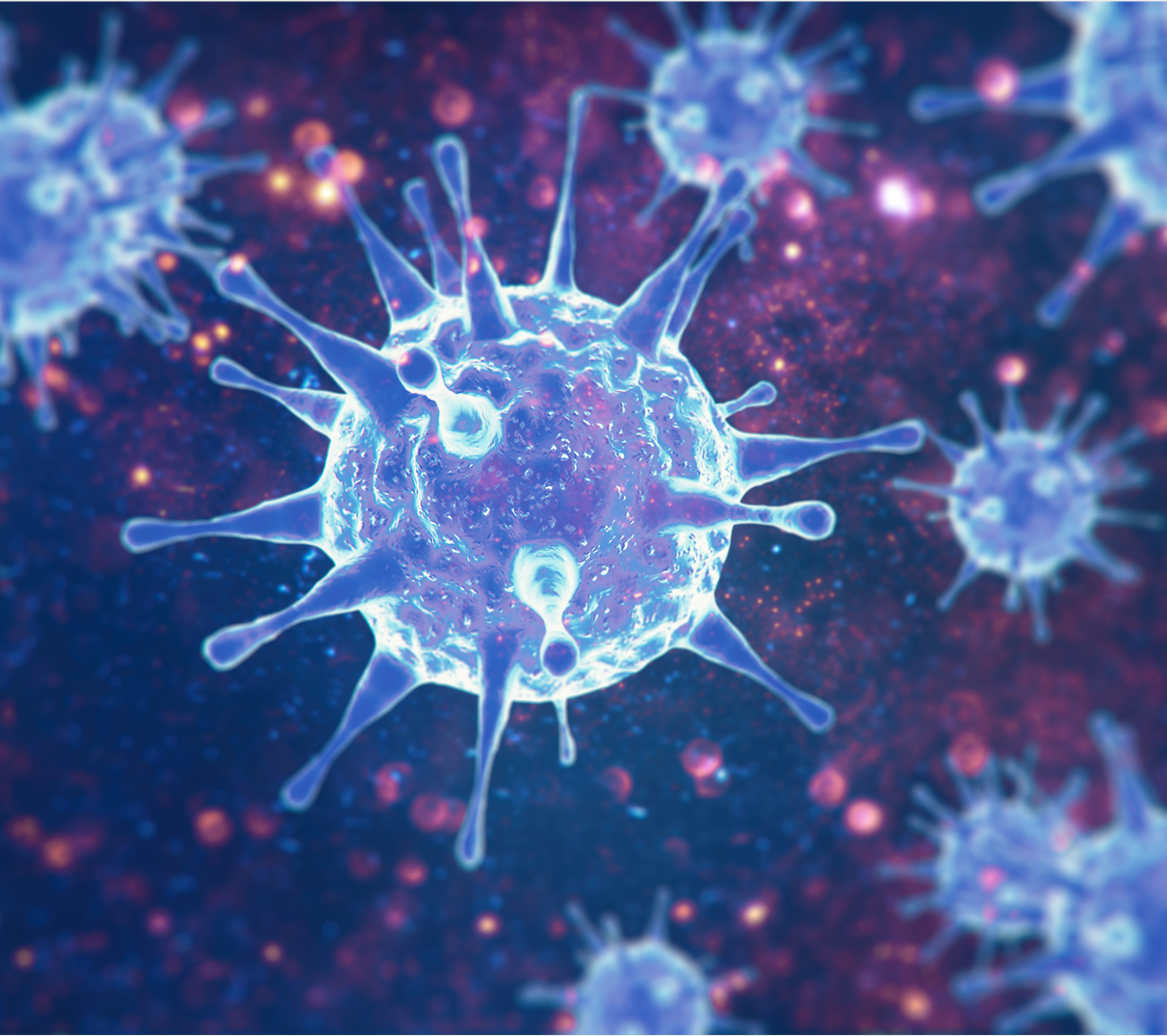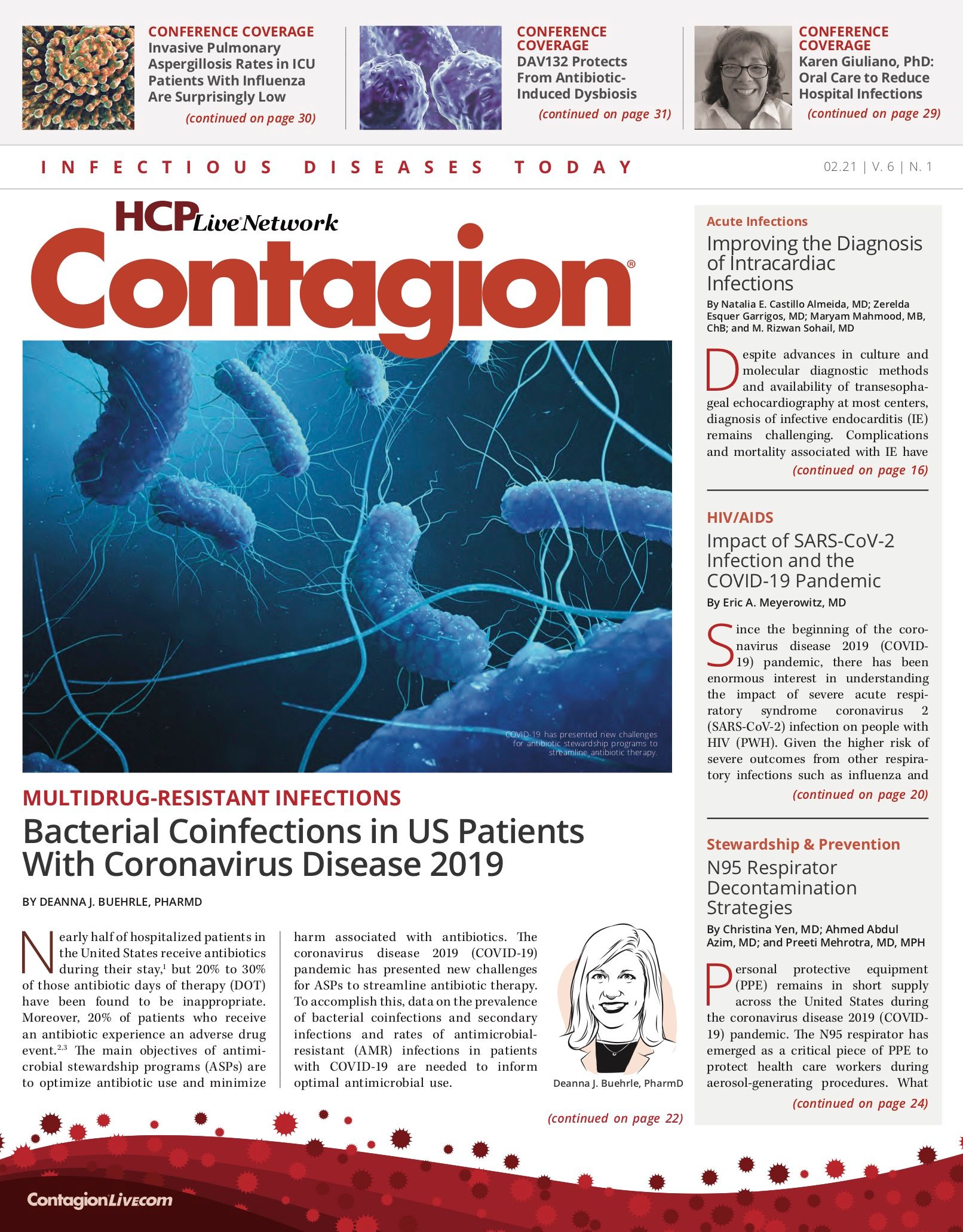Emerging Infectious Diseases During COVID-19
In this era of increasingly mobile and connected populations, it is possible for an infection to spread around the world in 24 to 48 hours.

Infectious diseases have repeatedly reshaped the course of civilization, resulting in significant human suffering and death along with substantial economic costs. Over the past 40 years, there has been a 4-fold increase in the number of emerging pathogens, such as extensively drug- resistant tuberculosis (XDR-TB), Severe Acute Respiratory Syndrome Coronavirus (SARS-CoV), pandemic H1N1, Middle East Respiratory Syndrome Coronavirus (MERS-CoV), Nipah virus, Zika virus, Multi Drug Resistant Organisms (MDROs), and Ebola virus.1 Public health threats and infectious diseases respect neither boundaries nor barriers, and 70% of the world is underprepared to prevent, detect, and respond to them quickly and effectively.
In this era of increasingly mobile and connected populations, it is possible for an infection to spread around the world in 24 to 48 hours, due to urbanization, human behavior, and rapid transportation networks.
SARS CoV-2, the virus responsible for the COVID-19 pandemic, is the latest novel pathogen to emerge, leading to over 95 million cases and 2 million fatalities globally as of January 18, 2021.2 Although the pandemic has had a broad human, economic, and social impact, it is one of many infectious diseases that has had important public health implications over the past year. In this article, we review and discuss some of the most notable infectious disease outbreaks and trends of the past year and where appropriate, indicate how they were impacted by COVID-19.
EBOLA
As the world rang in 2020, most of the global health community was focused on the 10th Ebola virus disease (EVD) outbreak that had been ravaging eastern Democratic Republic of the Congo (DRC) since August 1, 2018.3 Although the DRC had successfully contained more EVD outbreaks than any other country in the world, trying to end the one in the eastern North Kivu and Ituri provinces was difficult given the challenges of it occurring in a war zone. This outbreak was unlike any in the past; insecurity from years of violence had caused deep-seated community mistrust, intensifying the largest and most complex outbreak in the country’s history.
As COVID-19 gained traction across the globe, attention and resources shifted away from Ebola toward understanding and containing the newly emerging pathogen. Despite this pivot, the global community’s investment in developing fundamental principles of outbreak response and their commitment to deploying a vaccine in eastern DRC were critical to declaring an end to the Ebola outbreak on June 25, 2020. Similarly, it was the swift implementation of these principles that allowed DRC to quickly detect, isolate, contain, trace, and declare an end to their 11th EVD outbreak, in less than 6 months which arose in Equateur Province on June 1, 2020, and was declared over on November 18, 2020.4
The core principles of an Ebola response are anchored in any good infectious disease outbreak response. They include disease surveillance, strengthening laboratory capacity, infection prevention control, isolation and quarantine of suspect cases, contact tracing, and investment in building health care systems. Investment in these components began in 2018 at the beginning of the Ebola outbreak; thus, when COVID-19 emerged, the country was prepared to tackle this new threat. Since the emergence of the COVID-19 pandemic, the government has reinforced public health measures such as the mandatory wearing of face masks in public and limiting the number of individuals who can gather in crowds.5 They have also partnered with non-governmental organizations to implement community awareness campaigns and engagement around COVID-19 via radio, SMS communications, and mobile caravans.5 The combined efforts have been positive, and as of January 18, 2021 the DRC has reported approximately 20,625 cases of COVID-19.6
VACCINE PREVENTABLE DISEASES
While the world fights a new foe, we are still in the midst of combating long-standing adversaries such as vaccine-preventable diseases. Despite historic achievements in vaccine development and availability, more than 1.5 million people worldwide die each year from vaccine-preventable diseases.7 The COVID-19 pandemic has disrupted the way we fight diseases such as measles, diphtheria, and polio by hindering routine immunization services around the world. This puts at least 80 million children under age 1 in at least 68 countries, both poor and rich, at risk of these dangerous diseases.8 Diphtheria, for example, is appearing in Nepal, Pakistan, and Bangladesh; in polio-endemic Afghanistan and Pakistan, eradication efforts are threatened by the pandemic. Furthermore, nearly 41 countries may have put off their measles campaigns for 2020 or 2021, even though the World Health Organization has reported at least 7476 cases of measles in 10 countries between May and October 2020.9
Even in the United States, vaccine-preventable diseases still pose a significant threat. Whooping cough (pertussis), for example, remains common, resulting in 120,000 cases between 2014 and 2019.10 Cases were still occurring throughout the country in 2020. A Florida Department of Health report in June 2020 shows a general decrease in certain vaccine-preventable activity, but also notes that the pandemic has affected health seeking behavior, which may be affecting diagnoses and reporting.11
Delays and disruption to vaccine administration programs from measles to polio can set back years of progress made in global health, endanger children’s health, lead to loss of herd immunity, and have a costly impact on health care. Additionally, it can further strain hospitals, affect productivity and the economy due to illness, increase disability and death, and create the potential for larger outbreaks around the world.
MULTIDRUG RESISTANT ORGANISMS
The prevalence of multidrug-resistant organisms (MDROs) is increasing globally and locally, including here in the United States. An emerging multidrug-resistant fungus, Candida auris, has become a scourge in many countries and has caused havoc in the US over the past few years.12 As of September 2020, 22 states have reported 1433 confirmed and 30 probable cases.12 Although COVID-19 has dominated the headlines, MDROs continue to spread, often unchecked, with ongoing delays in reporting and tracking. A recent health advisory in California from August 2020, for example, noted that staying vigilant and preventing the spread of MDROs and C. auris is still of the utmost importance amidst the ongoing pandemic, as increased numbers of C. auris continue to be reported. In fact, the advisory noted that C. auris cases in California had more than doubled in health care facilities from May (n = 15) to June (n = 40) 2020. In July 2020 cases (N = 73) also exceeded the combined total number of cases in April, May, and June (n = 59) 2020.13 This noted increase is attributed to conservation strategies that facilities were using for COVID-19, such as extended use and reuse of personal protective equipment (PPE) and other containment practices such as grouping patients based on COVID-19 status.
C. auris is not the only MDRO emerging during the pandemic. A hospital in New Jersey also reported a cluster of 34 cases of carbapenem-resistant Acinetobacter baumannii (CRAB), which peaked during the spring surge of COVID-19 hospitalizations due to deviations in infection control strategies.14
In India, probable hospital-acquired C. auris bloodstream infections in critically ill patients with COVID-19 were noted in 2.5% of intensive care unit patients between April and July 2020.15 The potential attribution of infection was via indwelling invasive devices, contamination of the hospital environment, and incorrect and extended use of PPE leading to self-contamination and transmission of the opportunistic fungal pathogen. Likewise, the COVID-19 pandemic is affecting antimicrobial stewardship activities and driving antimicrobial resistance around the world.16
Overall, COVID-19 is leading to increased hospitalization rates of high-acuity patients, longer hospital stays in crowded facilities, antimicrobial overuse, extended use and re-use of PPE, and shortages of staff. Such factors play a role in contributing to the emergence and rise of health care–acquired infections with MDROs.
Currently, the global health workforce and its resources are stretched thin and are mostly dedicated to combating the COVID-19 pandemic. If Ebola, Zika virus, C. auris, SARS-CoV-2, and other emerging infections have taught us anything, it is that we must work with partners in other countries, particularly those that have limited resources to combat emerging infectious diseases. This is where novel pathogens are likely to emerge but unlikely to be recognized and reported quickly as a result of fragile healthcare infrastructure. As a result, we also must invest in strengthening global capacities across the globe such as public health and health care systems, to prevent, detect, and respond to infectious diseases threats in resource-limited settings. These measures will help move us toward strengthening the global health security agenda and meeting global pandemic preparedness goals. Finally, we need sustained resources to support resource-limited countries in strengthening surveillance and reporting systems, laboratory capacities, infection control efforts, and health care workforce training. This will ensure we have a robust capacity and capability to develop new tools and approaches to respond to infectious diseases with pandemic potential.
The world is constantly changing. We have altered how we live and the planet on which we live, including the way we interact with nature, manmade environments, and animals. We have changed the way we travel, and our climate. This has created the perfect storm for infectious diseases outbreaks and unprecedented opportunities to prevent and respond to them. Critically, we must work together as a global community to address COVID-19 and prepare for future emerging infectious disease threats.
Krutika Kuppalli, MD, FIDSA, is an assistant professor in the Division of Infectious Diseases at Medical University of South Carolina in Charleston and an Emerging Leader in Biosecurity Fellow at Johns Hopkins Center for Health Security in Baltimore, Maryland.
Syra Madad, DHSc, MSc, is an infectious disease epidemiologist serving as the senior director of the System-wide Special Pathogens Program at NYC Health + Hospitals, and health and safety lead of the NYC Test & Trace Corps Enhanced Investigation Unit, in New York, New York.
References
1. 2019-nCoV: Spread of coronavirus highlights need for strengthened global health security. Science Speaks Blog. Accessed January 18, 2021. https://sciencespeaksblog.org/2020/02/05/2019-ncov-spread-of-coronavirus-highlights-need-for-strengthened-global-health-security/
2. Johns Hopkins University COVID-19 Dashboard. Accessed January 18, 2021. https://gisanddata.maps.arcgis.com/apps/opsdashboard/index.html#/bda7594740fd40299423467b48e9ecf6
3. Schindell B et al. What the 2018 DRC Ebola Epidemic Taught Us About Outbreak Response and Experimental Countermeasures. Accessed January 18, 2021. What the 2018 DRC Ebola Epidemic Taught Us About Outbreak Response and Experimental Countermeasures
4. WHO. Ebola virus dissease- Democratic Republic of the Congo. Accessed January 18, 2021. https://www.who.int/csr/don/18-november-2020-ebola-drc/en/
5. Reliefweb. Democratic Republic of the Congo (DRC) - Ebola Situation Report #37 - January 8, 2021. Accessed January 18, 2021. https://reliefweb.int/report/democratic-republic-congo/democratic-republic-congo-drc-ebola-situation-report-37-january-8
6. WHO. Democratic Republic of Congo Situation Report. Accessed January 18, 2021. https://covid19.who.int/region/afro/country/cd
7. Okwo-Bele J-M. Together we can close the immunization gap. Accessed January 18, 2021. https://www.who.int/mediacentre/commentaries/vaccine-preventable-diseases/en/
8. WHO. At least 80 million children under one at risk of diseases such as diphtheria, measles and polio as COVID-19 disrupts routine vaccination efforts, warn Gavi, WHO and UNICEF. Accessed January 18, 2021. https://www.who.int/news/item/22-05-2020-at-least-80-million-children-under-one-at-risk-of-diseases-such-as-diphtheria-measles-and-polio-as-covid-19-disrupts-routine-vaccination-efforts-warn-gavi-who-and-unicef
9. CDC. Global Measles Outbreak. Accessed January 18, 2021. https://www.cdc.gov/globalhealth/measles/data/global-measles-outbreaks.html?CDC_AA_refVal=https%3A%2F%2Fwww.cdc.gov%2Fglobalhealth%2Fmeasles%2Fglobalmeaslesoutbreaks.htm
10. Outbreaks of Vaccine-Preventable Diseases. Vaccinate Your Family. Accessed January 18, 2021. https://vaccinateyourfamily.org/questions-about-vaccines/outbreaks-of-vaccine-preventable-diseases/
11. Vaccine-Preventable Disease Surveillance Report. Florida Department of Health. Accessed January 18, 2021. http://www.floridahealth.gov/diseases-and-conditions/vaccine-preventable-disease/_documents/2020-june-vpd-surveillance-report.pdf
12. CDC. Tracking Candida auris. Accessed January 18, 2021. https://www.cdc.gov/fungal/candida-auris/tracking-c-auris.html
13. LAHAN. CDPH Health Advisory: Resurgence of Candida auris in Healthcare Facilities in the Setting of COVID-19.
14. Perez S et al. Increase in Hospital-Acquired Carbapenem-Resistant Acinetobacter baumannii Infection and Colonization in an Acute Care Hospital During a Surge in COVID-19 Admissions — New Jersey, February–July 2020. MMWR. Accessed January 21, 2021. https://www.cdc.gov/mmwr/volumes/69/wr/mm6948e1.htm
15. Chowdhary A et al. Multidrug-Resistant Candida auris Infections in Critically Ill Coronavirus Disease Patients, India, April–July 2020. Emerging Infectious Diseases. Published 2020. Accessed January 18, 2021. https://wwwnc.cdc.gov/eid/article/26/11/20-3504_article#:~:text=In New Delhi%2C India%2C candidemia,rate was high (60%25)
16. Getahun H et al. Tackling antimicrobial resistance in the COVID-19 pandemic. WHO Bulletin. Accessed January 18, 2021. https://www.who.int/bulletin/volumes/98/7/20-268573/en/

